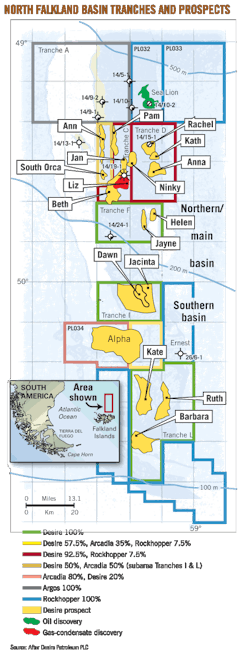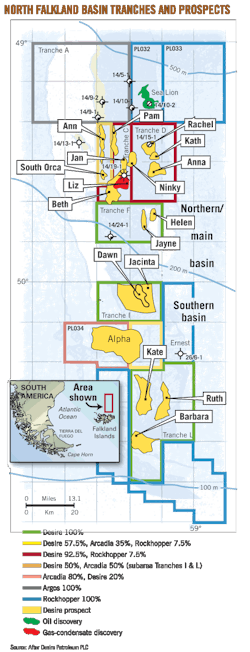Eric Watkins
Oil Diplomacy Editor
The initial excitement over exploration off the Falkland Islands has cooled considerably following BHP Billiton's recent decision not to enter the second phase of the southern 2002 licenses with erstwhile partner Falklands Oil & Gas Ltd (FOGL).
"BHP's pull-out is a major setback for FOGL's ambitions to tap into resources surrounding the Falkland Islands, particularly after competitor Rockhopper Exploration has been successful with its Sea Lion 1 well in the North Falklands basin," said analyst IHS Global Insight.
"If anything, the situation indicates that the resource potential off the Falkland Islands is far from clear," the analyst said, adding that the departure of BHP Billiton "certainly does not send encouraging signals to other companies potentially interested in exploring the Falklands."
No reason was given for BHP Billiton's decision, but industry observers noted that FOGL's first well had failed and that the firm also had warned that, due to a rig shortage, it would be unable to drill any further prospects this year.
In July, BHP Billiton and FOGL said they had encountered no reservoired hydrocarbons and would plug Toroa F61/5-1, their first exploratory well in the East Falkland basin in the South Atlantic (OGJ Online, July 13, 2010).
Falklands Oil & Gas undaunted
Still, despite BHP Billiton's decision to withdraw, FOGL said it would press ahead with its exploration program anyway.
"FOGL believes, based on the drilling results from the Toroa well analysed to date, that these licenses are still prospective," the firm said.
"FOGL has identified a number of prospects and leads which may prove to be of interest, particularly in the event of drilling success in the deepwater area of the northern licenses, or in the south, where the licenses are contiguous with acreage held by Borders and Southern Petroleum," the British firm said.
As a result, FOGL said it has decided to enter the second phase of its licenses, which entails the drilling of a single exploration well by Dec. 3, 2015.
Meanwhile, other explorers--including Desire Petroleum and Rockhopper Exploration—also remain upbeat on their prospects in the region. Indeed, Desire, which is wholly focused on the North Falkland basin, spudded its Rachel 14/15-1 exploration well on Sept. 27.
"The Rachel prospect is located in Tranche D and has an estimated target depth of 2,850 m," Desire said, adding that its drilling operations are expected to take 35 days and that a further announcement will be made once drilling is completed.
Rockhopper updates Sea Lion discovery
Just a few days before Desire's announcement, Rockhopper provided an update from the recent flow test on its Sea Lion-1 well, saying the test was carried out over four perforated intervals totaling 77 m between 2,403 m and 2,566 m below the drill floor.
"Upon retrieving the perforating guns, a gun misfire was apparent and only the top two intervals were found to have been perforated, meaning the lower two intervals did not contribute to the flow," Rockhopper said.
After perforation, Rockhopper said a small amount of oil was produced into the tubing to clean the perforations and enable downhole oil sampling. The well was then shut in for approximately 2 hr to determine the initial reservoir pressure.
"The final recorded pressure was 3,385 psia at gauge depth (2,344.6 m below drill floor) and was still building," Rochopper said.
The British firm said the well was then opened to flow through the 3.5-in. test string, initially on a 24⁄64-in. choke, opened to a 64⁄64-in. choke during the flow period, and reduced to 44⁄64-in. towards the end of the flow period to allow samples to be taken.
Rockhopper said the well was flowed for 18 hr without incident and for sustained periods of over 2,000 b/d with a maximum rate of 2,304 b/d.
Sea Lion flow impediments
Rockhopper recorded 120 psia final flowing wellhead pressure at Sea Lion, adding that a "wax dissolver chemical was injected at the subsea test valve to mitigate the appearance of wax."
Rockhopper said it believes the flow rate was inhibited by "incomplete perforation, waxing of the tubing string above 800 m, increased viscosity of the oil as it cooled in the upper part of the test string, and a lack of specialist equipment."
As such, Rockhopper estimates that the well could have flowed at 4,000 b/d without these constraints, and that "with a more optimal well location and horizontal well completions, significantly higher flow rates could be achieved from future production wells."
Due to the wax problem, analysts at Mirabaud Securities said the current valuation of Rockhopper's shares "underestimates the considerable appraisal and development risks associated with Sea Lion, and we firmly believe that any industry valuation of these assets would be significantly lower."
As such, Mirabaud said that Rockhopper "will have to rely on equity investors to finance the next phase of appraisal, increasing the likelihood of a near-term fund raising. Against this backdrop, we would look to take profits."
Argentina exploration program
Despite the uncertain results of exploration by these British-led firms, Argentina's government remains determined to ensure that its purported rights over the region's hydrocarbon potential remain intact.
Early in October, reports indicated that Argentina is preparing to start drilling for oil close to the Falkland Islands using a superdrillship hired from Stena Drilling.
A joint venture comprised of Repsol YPF, Petroleo Brasileiro SA (Petrobras), and Pan American Energy (a joint venture between BP 60% and Argentina's Bridas 40%), has been formed to carry out the campaign.
The drilling unit scheduled to carry out the work is the Stena DrillMAX, a harsh environment unit.
The location chosen to start the Argentine campaign in December 2010 is said to be some 290 km offshore, located in as much as 1,500 m of water halfway between the Falkland Islands and Tierra del Fuego on the southern tip of South America.
That positioning would put the program in the Malvinas basin, which already produces oil and gas in Argentina and Chile, not the San Julian basin where most of the Falklands exploration has taken place so far.
Argentina sees impasse over 1980s war
In the 1980s, Argentina and the United Kingdom fought a war over the Falkland Islands. The United Nations General Assembly called for the two countries to negotiate sovereignty over the islands following that war, which Britain won.
But London consistently rules out any concessions involving the islands, while Buenos Aires still claims sovereignty over them.
That continuing political impasse was underlined when Argentina's minister of defense Nilda Garre was reported as saying that the upcoming exploration campaign is intended to reinforce Buenos Aires' claims of sovereignty over the region and also to contain the "encroaching" British companies.
Garre's remarks follow a speech by Argentina's President Cristina Fernandez de Kirchner at the UN General Assembly in September in which she criticized the UK for ignoring Argentina's demand for sovereignty over the Falklands.
"The United Kingdom systematically refuses to establish negotiations with Argentina in order to deal with our conflict," Kirchner told the Assembly, adding that "they are depleting natural resources."
More Oil & Gas Journal Current Issue Articles
More Oil & Gas Journal Archives Issue Articles
View Oil and Gas Articles on PennEnergy.com

